Top News
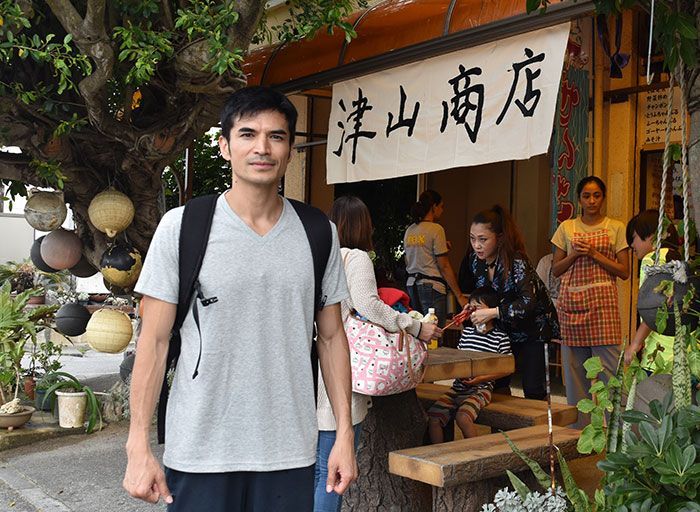
October 22, 2021 Ryukyu Shimpo
GENSAN PUNCH, the Japan-Philippines co-production film starring Okinawan actor Shogen, directed by Filippino director Brillante Mendoza, won the Kim Jiseok Award in South Korea’s 26th Busan International Film Festival (Oct 6-15).
The award honors the late Kim Jiseok, a founding member of the Busan Film Festival, and is given to the most attractive film reflecting the contemporary status of Asian cinema.
GENSAN PUNCH is based on the true story of Naozumi Tsuchiyama (played by Shogen), whose prosthetic leg disqualified him from boxing professionally in Japan. Tsuchiyama traveled to the Philippines to pursue his aspiration with his coach and friends.
Shogen wrote on Twitter, “My heart is full. All our hard work was rewarded. I hope I was able to repay the people who believed in my dreams [with this award]. Thank you so much for your support.”
(English translation by T&CT and Monica Shingaki)
Go to Japanese
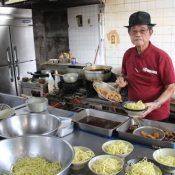
October 17, 2021 Ryukyu Shimpo
October 17 is Okinawa Soba Day. At the Gabusoka Shokudo Honten in Gabusoka, Nago, which opened 55 years ago, the person standing in the kitchen is none other than its founder Genji Kinjo, 92.
“Nothing makes me happier than to be told ‘that was delicious.’” Except for Monday when the restaurant is closed, Kinjo still has his energy as he carefully stews soki, Okinawan spare pork ribs, serving them with homemade noodles everyday from 10 a.m. to 3 p.m.
When he was 30, he escaped his office job and returned to his hometown Gabusoka, where he ran a fresh meat and fish market and a general store and came up with his idea for “Soki soba,” made using the leftover unsold soki. Rather than letting it go to waste, he brought it home and made a dish with soba noodles, serving it to his kids to rave reviews. In 1966 he founded the Gabusoka Shokudo, and the new dish being sold for 25 cents topped with the delicacy soki quickly took the town by storm. A dish created to prevent food waste had become the popular flagship product at the “original soki soba restaurant.”
Kinjo said smiling, “I am filled with energy when I see the shop filled with customers. I want to keep doing this as long as I am able.”
(English translation by T&CT and Sam Grieb)
Go to Japanese
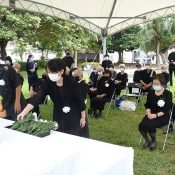
October 12, 2021 Ryukyu Shimpo
The Naha City war dead memorial service (the 26th Naguyake Monument memorial, hosted by Naha City and Naha City Council) was held October 10 at the Naguyake Monument in Asahigaoka Park in Wakasa, Naha. The ceremony was attended by 26 people, representatives from Naha City and descendants of those who perished in the air raid. Because of concerns over the spread of COVID-19, the ceremony was smaller in size than usual, similar to the previous year’s memorial.
Naha Mayor Mikiko Shiroma said in her memorial address, “77 years ago today, the air raid devastated Naha, burning down 90% of the town, taking the lives of many of its residents. Those of us who are living have a responsibility to tell future generations of the tragedies from the great war.”
Ryoyu Zukeyama, president of the Naha Survivors’ Association, said in his memorial address, “We need to teach our descendants the sad realities of the war dead, and all of us need to work together to respect peace so that another calamity brought about by war cannot happen again.”
(English translation by T&CT and Sam Grieb)
Go to Japanese
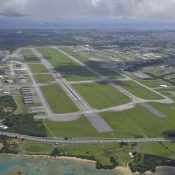
October 14, 2021 Ryukyu Shimpo
By Wakana Arakaki
Residents of the areas surrounding Kadena Air Base are pursuing a Kadena noise lawsuit through which they are addressing damage caused by noise from U.S. military aircraft and are requesting, among other things, a ban on flights in the late night and early morning. News coverage about the plaintiffs’ preparatory conference on October 13 revealed that there are over 30,000 plaintiffs for this fourth sequential Kadena noise lawsuit who are making their preparations. The number of plaintiffs has increased since the third such lawsuit when the plaintiffs numbered about 22,000, becoming the largest domestic class-action lawsuit to date. The plaintiff group is accepting more participants until the end of the month, and these participants plan to come together at the end of January next year to present their case.
The plaintiffs are from five municipalities neighboring Kadena Air Base, these being Kadena Town, Chatan Town, Okinawa City, Uruma City, and Yomitan Village. These plaintiffs are residents who live in areas having a noisiness index (W value) of 75 or greater on a noise contour (distribution map) provided by the Japanese government. There is a tendency among younger generations to join the plaintiffs, and it appears a contributing factor to this may be their high level of familiarity with the movement. The fourth lawsuit will request, as did the third lawsuit, a ban on flights of US military aircraft in the late night and early morning, damages for past and future mental distress and the like caused by the noise, and more.
In the third lawsuit, the decision of the Naha branch of the Fukuoka High Court recognized the noise damage caused in the past, and ordered the Japanese government to pay a total sum of 261 billion yen to 22,020 people. The court set aside the matter of a flight ban given that, according to the “third party act theory”, the court is not in a position where it can regulate US military bases.
Shusei Arakawa, 84, a leader of the plaintiffs group in the third lawsuit and the head of the plaintiffs’ preparatory conference, said that “Even 76 years after the war I am forced to hear the roar [of aircraft], and the anger is spreading throughout my day-to-day life. For about 40 years the number of people involved with the movement has been growing”.
The first Kadena noise lawsuit took place in 1982, the second took place in 2000, and the third took place in 2011.
(English translation by T&CT and Erin Jones)
Go to Japanese
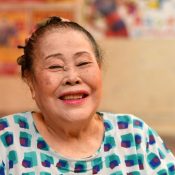
October 12, 2021 Ryukyu Shimpo
The Japan Film Festival Los Angeles 2021, which took place October 10, awarded Sachiko Nakada, 89, star of the movie “NANKURUNAISA” best actress at the festival. Her film also took home the award for best comedy.
Nakada told this paper happily, “I am very happy to hear that I have fans in other countries, and that they laughed until they cried.”
(English translation by T&CT and Sam Grieb)
Go to Japanese

October 13, 2021 Ryukyu Shimpo
Tokyo – On October 11, Natsuko Izena and her collaborators held a press conference at the National Diet and announced the launch of their website for victims of online defamation, Online Safety for Sisters. Izena, a columnist who lives her life in a wheelchair, held the conference in response to the continuing victimization of women on Twitter and other social media platforms. Their website collects online signatures calling on the Japanese government to pass a law requiring social media companies to have measures to prevent defamation.
Izena herself was a victim of online defamation after blogging in April about her own experience at a JR station in Kanagawa where she was refused use of an unmanned station because she requires the assistance of a station attendant.
Anonymous comments calling her a “nuisance to society” and a “waste of taxpayer money” poured in. She explained, “My life fell apart. It felt like I was being attacked by a mob.” Lies such as one that she was “abusing the helper system” spread. To date, she has received more than 45,000 defamatory comments on Twitter, and more than 8,000 on Yahoo.
Yumi Ishikawa, an actress and activist known for her work with the #KuToo movement, and Nahoko Hishiyama, a social activist, also participated in the press conference. Both women work to promote women’s rights, and have experienced similar social media defamation. Ishikawa says, “If we don’t speak up, nothing will change. It’s vital that we create an environment in which anyone can speak up.” The women are working to collect signatures and to train people to support women who have been victimized.
Izena called for the “creation of a society in which women can feel comfortable using social media.”
Their website is http://onlinesafetyforsisters.com/
(English translation by T&CT and Ellen Huntley)
Go to Japanese

October 5, 2021, Ryukyu Shimpo
According to temperatures recorded in 47 prefectural capitals across Japan, Aomori, Sendai, and Naha were the only cities this summer to experience zero “extremely hot” days, defined as temperatures of 35 Celsius degrees or higher. Naha City’s hottest day was 33.5 degrees, the lowest in Japan.
According to the Japan Meteorological Agency, the highest temperatures recorded between July and September in the three cities were 34.2 Celsius degrees in Aomori City on July 19 and 34.5 degrees in Sendai City on August 5. Naha City, which recorded a high of 33.5 degrees on September 10, was the only prefectural capital in Japan to remain below 34. Meanwhile, Sapporo City, Hokkaido, recorded a total of three “extremely hot” days.
Naha City has recorded a daily high temperature of 30 degrees and above since September as of October 4.
The prefectural capital with the hottest day this summer was Osaka City, at 38.9 degrees Celsius on August 5.
(English translation by T&CT and Monica Shingaki)
Go to Japanese
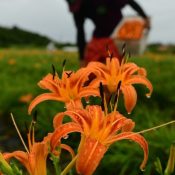
October 8, 2021 Ryukyu Shimpo
In the 24 sekki, which are days that divide the year into 24 solar terms, October 8 is Kanro, marking a time of year when cold air comes in, and dewy mornings are evidence of the deepening autumn. In the fields of Nemurigusa Honpo, a farm in Kamiunten in Nakijin where kuwanso (orange day lilies) are cultivated, the flowers are in bloom. Visitors enjoy the bright vermillion blossoms.
Kuwanso is a traditional vegetable in Okinawa. The plant is known for its characteristic crisp flowers and sweet stems and is said to have a relaxing effect.
On October 7, the weather around Okinawa was cloudy and rainy, but even covered in raindrops, the color of the kuwanso flowers enlivened the entire field.
(English translation by T&CT and Ellen Huntley)
Go to Japanese
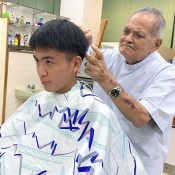
October 7, 2021 Ryukyu Shimpo
By Hideki Matsudo
Nago – The “Kinjo Riyouten” barbershop in Miyazato, Nago, owned by Kisei Kinjo, finally served its final customer October 1 after 48 years in business. The last person to get their hair cut by Kinjo was his grandson Kyoka, 18. The store, which Kinjo ran with his late-wife Toshiko (who passed away 8 years ago at age 79), as well as Kinjo’s personality, were beloved by the local community. Kinjo said smiling, “I wanted to keep cutting hair until I was 100 years old. There were a lot of good things that came from working earnestly until now.”
Kinjo, who was born and raised in Genka, Nago, had to evacuate his home during the Battle of Okinawa, walking around 35 kilometers with his family to Takae in Higashi Village. They ate plums to stave off hunger during the war, and after it ended, he attended Genka Elementary and Haneji Junior High School, but he didn’t make it into high school.
Disheartened, Kinjo shut himself up at home, but regained some of his spirit taking care of a horse his mother acquired from selling pigs while struggling to make ends-meat. He worked on a U.S. military base for a while as a janitor, he started an apprenticeship at the Tairakawa and Oshiro barber shops at Koz
a Crossroads in Koza (now Okinawa City), then started working as a barber at the Camp Foster and Camp Schwab military bases.
“Since all the soldiers just got buzz cuts with clippers, didn’t use that much English,” he said nostalgically. A haircut cost 25 cents, and hairstyling cost 10 cents. “By offering a variety of services I could make more than I could just cutting hair. However, when the Vietnam War came the marines were all sent to the front lines,” he said, reflecting on the influence of the war.
The year Okinawa was reverted to Japanese control, Kinjo studied hard for two weeks and got his Japanese barber’s license. He bought some land along the road in Miyazato, at the time surrounded by fields, and built what would become his shop and his home. He was blessed with one son, Shigetoshi, 52, and three daughters, Yoshimi, 53, Tomoko, 50, and Fumiko, 47, however, “He worked from eight in the morning until eight at night, so I have almost
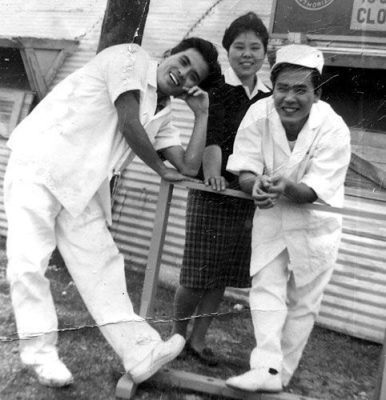
Kinjo (left) with his co-workers when he was cutting hair at Camp Schwab – 1969, Henoko, Nago
no recollection of him eating dinner with us on the weekdays,” recalls Yoshimi.
On busy days he could see as many as 30 customers. Around New Years, he “was busy until nine at night giving people new year haircuts.” Sundays the barber shop was closed, and he would take care of his family or work in the fields, but after so many years working on his feet he suffered from lower back pains, and had falls in the store resulting in broken bones, and finally decided to close the barber shop for health reasons.
On October 1, his 86th birthday, his children gathered at the barber shop to say “Thank you for 48 years,” and celebrated with a birthday cake. “One of the charms of this profession is that there is no retirement age. Because I could continue working, I was able to stay healthy all these years,” he said smiling. His final customer, his grandson Kyoka, 18, who is in his final year of high school, said, “I hope you continue to stay healthy.”
(English translation by T&CT and Sam Grieb)
Go to Japanese
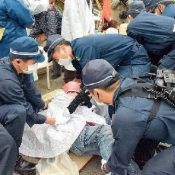
October 8, 2021 Ryukyu Shimpo
On October 7 the Nagoya High Court, ruling on a taxpayers’ suit concerning the deployment of riot police accompanying helipad construction in the Northern Training Area (NTA), made a decision that found illegality in the procedure used when choosing to deploy the riot police. The district courts of Tokyo, Nagoya, Fukuoka, and Naha all saw taxpayers’ suits charging that the deployment was illegal, but the taxpayers’ side lost in all of these first trials. The plaintiffs and interested parties from Okinawa feel hopeful that the Nagoya High Court finding in favor of some of the claims from the taxpayers’ side will “become a tailwind for Okinawa’s legal team”, and expressed their delight.
Tsuyoshi Kitaueda was directly contacted by Nagoya’s plaintiffs, and offered them words of encouragement, saying, “This is a splendid, groundbreaking decision.” The plaintiffs from each region had come together to cooperate as the plaintiffs in this suit in Okinawa. Kitaueda stated that the October 7 high court decision contained mention that the Okinawa Prefectural Public Safety Commission’s assistance request was significantly flawed, and he also explained that the decision was handed down with criticism for Okinawa’s handling of the situation, as well, and with an understanding of the crucial importance of the decision.
Yoichiro Hidaka, a lawyer experienced with lawsuits in Okinawa concerning the U.S. military, explained that in the first trial decision of this suit it was found that the procedural issue, specifically, the police chief of the Aichi Prefectural Police choosing to deploy the riot police on his own authority, was settled by an ex post facto report to the public safety commission. Hidaka also pointed out that the Nagoya High Court saw an issue with that finding because “it cannot be assessed, in an ex post facto report, that the public safety commission has performed substantial deliberation and approval/verification.” Hidaka also feels that the high court’s decision was appropriately judged on substance rather than logic.
The high court held that there is “strong doubt” about whether the riot police having removed vehicles and tents set up by citizens in front of the N1 zone gate of the NTA was illegal. Hidaka also touched on this matter, commenting: “The decision will become a tailwind for Okinawa’s legal team, as well. The Naha District Court avoided deciding upon whether or not the tent removal was illegal, but I expect that the Naha branch of the high court will face making that decision head-on.”
Kunio Uehara, one representative of the Okinawa Peace Movement Center, said that the Japanese government is using police authority to keep prefectural citizens down in order to carry out base construction, and suggested that the government is now being judged for its methods for moving construction forward, which go too far. He also said that although this lawsuit will probably go to the Supreme Court, he hopes that there, too, the judicial decision will uphold properly protecting the rights of Japanese citizens.
(English translation by T&CT and Erin Jones)
Go to Japanese
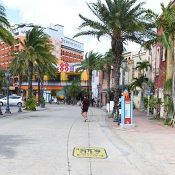
October 2, 2021 Ryukyu Shimpo
Chatan – On the day the emergency declaration was lifted on October 1, the number of people that could be seen in the American Village in Mihama, Chatan was sparse. There were some local shopers and tourists, but no where close to the activity seen before the pandemic.
There was a 38-year-old restaurant owner from Hyogo Prefecture visiting Okinawa with a friend. He comes to Okinawa twice per year, but it had been a year since he had visited Okinawa’s main island.
The man said, “I had some time so I came for some sightseeing. There seems to be much fewer people than previous visits. Since the pandemic has not ended yet, I think it may be another year before it goes back to the way it was before.”
Someone who works in a store in American Village said, “Since there has not been a lot of time since the emergency declaration was lifted, the number of customers hasn’t changed much. I am looking forward to the customers coming back.”
(English translation by T&CT and Sam Grieb)
Go to Japanese












 Webcam(Kokusai Street)
Webcam(Kokusai Street)


